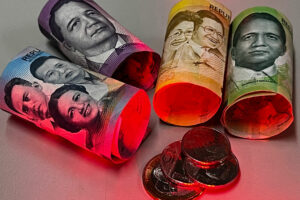THE PESO weakened anew on Tuesday, joining the Chinese yuan and other Asian currencies that weakened against the dollar.
The local unit closed at P56.68 per dollar on Tuesday, dropping by seven centavos from its P56.61 finish on Monday, Bankers Association of the Philippines data showed.
The peso opened the session weaker at P56.65 against the dollar. Its worst showing was at P56.77, while its intraday best was at P56.60 versus the greenback.
Dollars exchanged inched up to $1.459 billion on Tuesday from $1.458 billion on Monday.
The peso dropped after The People’s Bank of China fixed the rate for the yuan higher, which helped the dollar’s recovery, a trader said in a phone interview.
“However, the upside [for the dollar] remains limited due to trade tensions and a cautious market mood,” the trader said.
The peso fell due to the broad market volatility caused by US Donald J. Trump’s continued threats to fire Federal Reserve Chair Jerome H. Powell, threatening the independence of the US central bank, Rizal Commercial Banking Corp. Chief Economist Michael L. Ricafort added in a Viber message.
For Wednesday, the trader expects the peso to move between P56.50 and P56.80 per dollar, while Mr. Ricafort sees it ranging from P56.60 to P56.80.
The onshore Chinese yuan weakened to near 7.31 per dollar early on Tuesday, Reuters reported. The People’s Bank of China set the official midpoint at 7.2075 compared with 7.2055 on Monday, despite the dollar index’s slump to a three-year low.
The dollar continued its slide against major peers, pressured by Mr. Trump’s criticism of Mr. Powell and confrontational trade policies.
Investor confidence in US assets has wavered amid concerns over the Fed’s independence and the toll Mr. Trump’s tariffs could exact on the US economy.
The unease was visible across asset classes on Monday. US equities tumbled, while Treasuries declined.
The dollar index is down a substantial 5.7% this month, on track for its sharpest monthly drop in at least a decade. — A.M.C. Sy with Reuters
